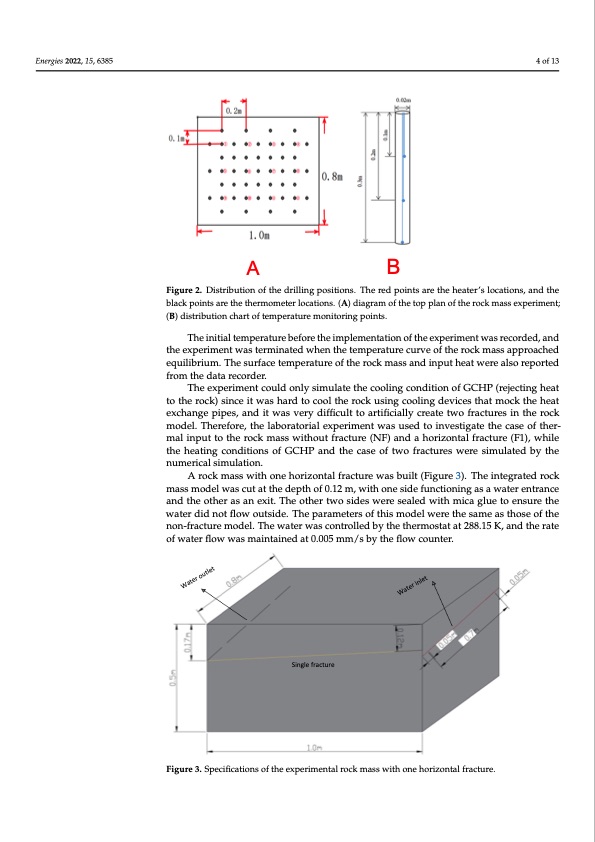
PDF Publication Title:
Text from PDF Page: 004
Energies 2022, 15, 6385 The experiment could only simulate the cooling condition of GCHP (rejecting heat to the rock) since it was hard to cool the rock using cooling devices that mock the heat ex- change pipes, and it was very difficult to artificially create two fractures in the rock model. Therefore, the laboratorial experiment was used to investigate the case of thermal input to the rock mass without fracture (NF) and a horizontal fracture (F1), while the heating conditions of GCHP and the case of two fractures were simulated by the numerical simu- lation. B Figure 2. Distribution of the drilling positions. The red points are the heater’s locations, and the Figure 2. Distribution of the drilling positions. The red points are the heater’s locations, and the blackpoiinttssaarreeththeeththeremrmomometetrelrolcoactiaotniosn. (sA. ()Ad)iadgiragmraomf tohfethoeptpolpanpolafnthoefrtohcekrmocakssmexapssereimxpeenrti;ment; (B)distriibuttiionncchhaartrtoofftetmemppereartautruermemonointoirtoinrginpgopinotisn.ts. AThreocinkitmiaalstsemwpitehraotnuerehboerifzoorentahlefirmacptulerme wenatsatbiounilto(fFtihgeuerxep3e)r.iTmhenitnwteagsraretecdorrdoecdk,and mthaesesxmpoedrieml wenatswcuatsatterthmeindaeptetdh owfh0e.1n2tmhe, wteimthpoenraetsuidrecfurnvcetionfitnhgearsoackwmataesrseanptrparnocaeched aenqduitlhiberioutmhe.rTahseasnuerxfaitc.eTtheemoptehreartutwreoosfidthese wroecrke mseaslesdanwditihnpmuictahegalutewteorenaslusorerethpeorted water did not flow outside. The parameters of this model were the same as those of the non-fracture model. The water was controlled by the thermostat at 288.15 K, and the rate The experiment could only simulate the cooling condition of GCHP (rejecting heat of water flow was maintained at 0.005 mm/s by the flow counter. to the rock) since it was hard to cool the rock using cooling devices that mock the heat exchange pipes, and it was very difficult to artificially create two fractures in the rock model. Therefore, the laboratorial experiment was used to investigate the case of ther- mal input to the rock mass without fracture (NF) and a horizontal fracture (F1), while the heating conditions of GCHP and the case of two fractures were simulated by the numerical simulation. A rock mass with one horizontal fracture was built (Figure 3). The integrated rock mass model was cut at the depth of 0.12 m, with one side functioning as a water entrance and the other as an exit. The other two sides were sealed with mica glue to ensure the Energies 2022, 15, x FOR PEER REVIEW water did not flow outside. The parameters of this model were the same as those of the non-fracture model. The water was controlled by the thermostat at 288.15 K, and the rate of water flow was maintained at 0.005 mm/s by the flow counter. Single fracture Figure 3. Specifications of the experimental rock mass with one horizontal fracture. Figure 3. Specifications of the experimental rock mass with one horizontal fracture. 2.4. Experimental Results and Discussion 5 of 15 4 of 13 from the data recorder. A The recorded data were imported into the processor to draw the temperature contour maps at different depths. The left column in Figure 4 shows the temperature fields at dif- ferent depths (0.1 m, 0.2 m, and 0.3 m) in the rock mass without fracture, and the right Water outlet Water inlet column shows the temperatures field at the same depths in the rock mass with a horizon-PDF Image | Research on the Application of Fracture Water

PDF Search Title:
Research on the Application of Fracture WaterOriginal File Name Searched:
energies-15-06385.pdfDIY PDF Search: Google It | Yahoo | Bing
Turbine and System Plans CAD CAM: Special for this month, any plans are $10,000 for complete Cad/Cam blueprints. License is for one build. Try before you buy a production license. More Info
Waste Heat Power Technology: Organic Rankine Cycle uses waste heat to make electricity, shaft horsepower and cooling. More Info
All Turbine and System Products: Infinity Turbine ORD systems, turbine generator sets, build plans and more to use your waste heat from 30C to 100C. More Info
CO2 Phase Change Demonstrator: CO2 goes supercritical at 30 C. This is a experimental platform which you can use to demonstrate phase change with low heat. Includes integration area for small CO2 turbine, static generator, and more. This can also be used for a GTL Gas to Liquids experimental platform. More Info
Introducing the Infinity Turbine Products Infinity Turbine develops and builds systems for making power from waste heat. It also is working on innovative strategies for storing, making, and deploying energy. More Info
Need Strategy? Use our Consulting and analyst services Infinity Turbine LLC is pleased to announce its consulting and analyst services. We have worked in the renewable energy industry as a researcher, developing sales and markets, along with may inventions and innovations. More Info
Made in USA with Global Energy Millennial Web Engine These pages were made with the Global Energy Web PDF Engine using Filemaker (Claris) software.
Sand Battery Sand and Paraffin for TES Thermo Energy Storage More Info
| CONTACT TEL: 608-238-6001 Email: greg@infinityturbine.com | RSS | AMP |